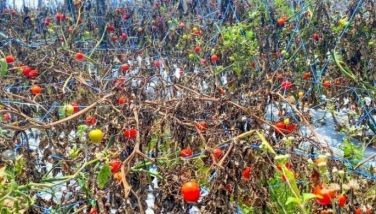Public warned: Brace for worse
CEBU, Philippines- The El Niño phenomenon is intensifying from moderate to “strong”, prompting the weather bureau to warn that the country is in for drier weather and that less rainfall is imminent, possibly starting in the next few weeks.
“The El Niño condition is still present in the tropical Pacific and is expected to continue and may intensify from moderate to strong in the coming months,” said Philippine Atmospheric, Geo-physical and Astronomical Services Administration-Mactan Chief Meteorologist Al Quiblat during a recent conference with local disaster councils.
Both the PAGASA and the Office of the Civil Defense said El Niño’s full impact is expected towards the third to the last quarter of the year, bringing dry conditions in most areas of the country.
Quiblat said the latest rainfall analysis showed that below normal rainfall conditions were already experienced in many parts of the country due to El Niño.
He said Cebu’s rainfall forecast is below normal from August to the remaining months of 2015. He said their data showed that 80 percent of the country has received below to way below normal rainfall since May.
The US National Oceanic and Atmospheric Administration’s Climate Prediction Center had said that this year’s El Niño is poised to join the ranks of the strongest such events on record like the 1950 El Niño.
Majority of international El-Niño Southern Oscillation climate models also suggest that tropical Pacific temperatures are likely to continue warming and possibly reach strong El Niño levels.
El Niño is a disruption of the ocean-atmosphere system in the tropical area of the Pacific, it having important consequences for weather and climate around the globe. The phenomenon occurs every two to seven years in varying intensity, and the waters of the eastern Pacific can be up to four degrees Celsius (7 degrees Fahrenheit) warmer than usual.
Cognizant of the situation, the Provincial Disaster Risk Reduction and Management Office warned the public to brace for the worse effects of the El Niño.
PDRRMO Chief Baltazar Tribunalo Jr. labeled the phenomenon as a “creeping disaster” whose effects, unlike typhoons, are not felt at once.
He advised the public and establishments not to be complacent and take precautionary measures, such as conserving water and installing water impounding facilities.
His office has already recorded depleting water supply in some areas in the province during the second quarter of the year, when El Niño was still weak.
As of June this year, El Niño has already caused more than P58 million in damage to crops in 22 local government units of the province.
This prompted the Cebu Provincial Board to place the entire province under a state of calamity last May.
Emilio Secretaria, chairman of the Cebu City Federation of Farmers Association and Cooperatives, said occasional rains and prolonged drought is taking their toll on crops.
He said farmers could not easily recoup income losses and damages on croplands because they are not all covered by the insurance program of the Philippine Crop Insurance Corporation.
“There’s free crops insurance for our farmers but not all did avail of this, except those surveyed under the Registry System on Basic Sectors in Agriculture,” he told The FREEMAN.
PCIC has the mandate to provide insurance protection to the country’s agricultural producers, particularly the subsistence farmers. Insurance programs offered by PCIC include Rice Crop Insurance, Corn Crop Insurance, High-Value Commercial Crop Insurance, Non-Crop Agricultural Asset Insurance, Livestock Insurance, Term Insurance, among others.
Sogod Federation of Farmers and Fishermen president Ines Densing said the dry season is affecting the growth of their crops, adding that “the hot weather makes the growth of crops and vegetables slower than normal.”
Secretaria said they are requesting the Department of Agriculture and the Cebu City Agriculture’s Office for water impounding and green house facilities.
The farmers, he said, are also taking steps to somehow lessen the effects of El Niño, like choosing a variety of crops that could withstand the current weather such as sweet potato, cassava and corn, which are quick-maturing and drought-resistant crops.
Allen Froilan Cabaron II, OCD-regional technical support division chief, said Bohol and Siquijor provinces are likewise affected by drought.
He said at least 60 percent of the country was affected by either drought or dry spell from October 2014 to May 2015.
OCD advised the public and the local Disaster and Risk Reduction and Management Councils to take precautionary measures of the possible impacts of the onslaught of El Niño, like conserving water.
PAGASA Visayas Director Oscar Tabada earlier said an unusual number of tropical cyclones is expected this year, adding that because of El Niño, the behavior of tropical cyclones may become “erratic, affecting its track and intensity.”
“Lesser but destructive because of El Niño,” he said of the phenomenon, which is projected to last until early next year. — /RHM (FREEMAN)
- Latest























